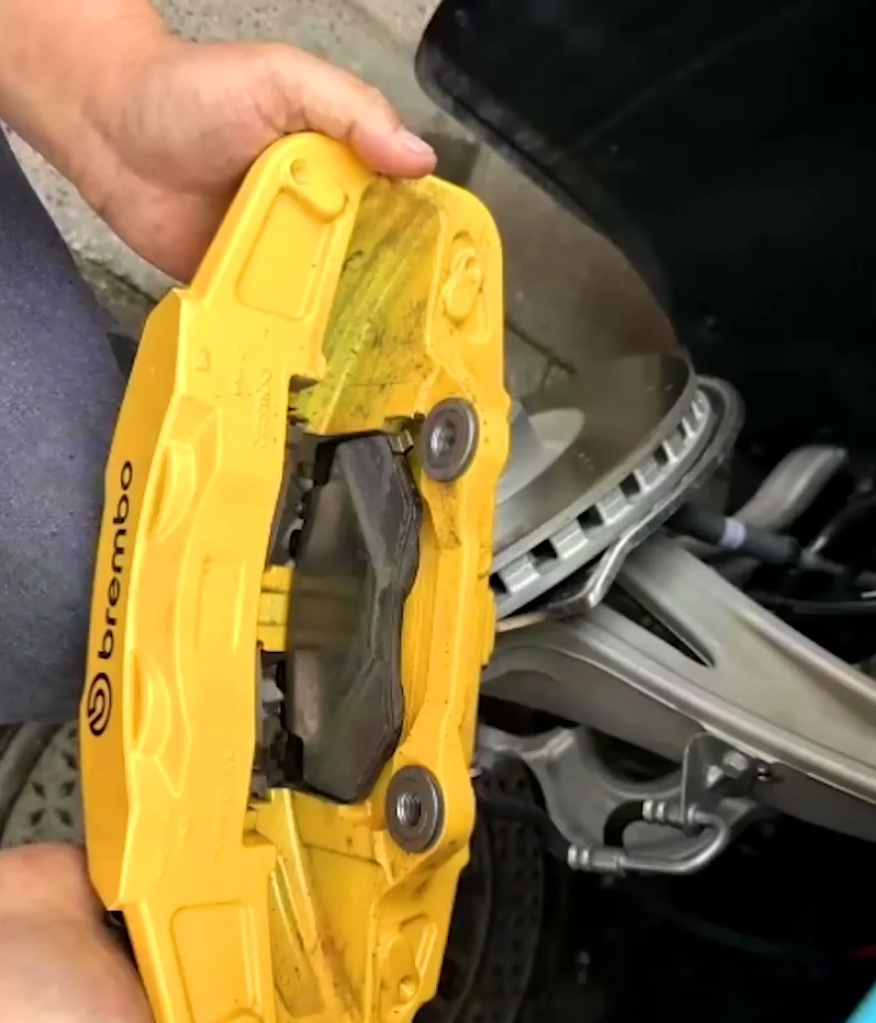Xiaomi admitted that the brakes of the 663 hp EV were designed for daily driving, not the track
November 15, 2024 at 14:25

- Xiaomi’s SU7 Max electric car has a braking problem on race tracks.
- Video evidence shows two examples of the brakes failing before a big crash.
- It turns out that the SU7 Max has smaller brake pads than those found on a Honda CR-V.
The Xiaomi SU7 Max is a proper EV sports sedan on paper. It makes 663 hp (673 PS / 495 kW). It can allegedly go from 0-62 mph (100 km/h) in just 2.8 seconds and drive up to 497 miles on a single charge. That’s a lot of speed but, evidently, the SU7 doesn’t have the brakes to reel it in on track.
In April, a Chinese influencer lapping the Shanghai Tianma circuit had a crash in the car. Video from the incident shows the driver start approaching a left-hand turn when things quickly go bad.
Read: Xiaomi SU7 Ultra On Sale From $114K, Watch Prototype Lap The ‘Ring In 6:46
Despite several attempts to get the car to turn it, it barely changes its direction and then barrels through the end of the track. At that point, it smashes into the barrier and the airbags go off. The video by Tang Zhu Liao Che (堂主撩車) has already racked up millions of views. Tang Zhu showed the brakes of the car, which had done five hot laps prior to the crash, and the relatively small pads were severely worn.
Then, in June, another influencer in an SU7 experienced a similar brake failure while driving at a track. In this situation, the driver seesawed at the wheel before the crash. When the car struck the wall it had turned almost all the way around. The airbags didn’t go off and the driver’s seat broke apart like it was made of cardboard.
Xiaomi issued the following statement, explaining that the SU7 Max is not meant for track use:
“We strongly remind you that Xiaomi SU7 Max is a high-performance luxury car for road use. Please do not try extreme driving such as on professional racing circuits. The braking system of Xiaomi SU7 Max uses NAO friction pads, which are suitable for daily driving. They are mainstream products that balance braking noise and braking performance and meet the needs of public road driving.
“Due to the high speed, large kinetic energy accumulation, sharp braking, and rapid wear of components under continuous high load and high temperature under track conditions, all core components of the vehicle are required to meet requirements far beyond those of daily conditions.”
NAO stands for non-asbestos organic. That material can work fine in daily driving. On a race track though, it’s proving problematic. Xiaomi itself has fitted the much more powerful SU7 Ultra, which broke the EV record at the Nurburgring last month with a 6:46.847 lap time, with carbon ceramic discs measuring 430 mm at the front and 410 mm at the rear. According to the company, they can withstand temperatures up to 2,372 F (1,300 degrees Celsius) and are much more resistant to fade during track use.
No doubt, having to slow down a car with this kind of power and one that weighs 4,365–4,861 lb (1,980–2,205 kg) isn’t easy. The Autopian points out that the Brembo brakes on the SU7 Max actually have pads that are smaller than those found on a Honda CR-V – a family SUV with roughly one-third of the power of the Chinese performance sedan.
Notably, during everyday driving, the regenerative braking power supplements the mechanical brakes. They’ll help out on track too, but they have limits as well. It’s why cars like the Hyundai Ioniq 5 N and the Porsche Taycan Turbo GT both have gigantic brakes when compared to the regular versions of those cars. Perhaps it’s time for Xiaomi to follow the lead of far more experienced automakers.


ivermectin 6mg over counter – ivermectin 3mg for humans for sale oral carbamazepine 200mg
sildenafil 50mg without prescription – tadalafil oral buy tadalafil for sale
prilosec 10mg tablet – order generic lopressor tenormin over the counter
desloratadine us – dapoxetine 30mg sale purchase dapoxetine pill
order generic cytotec – xenical pills diltiazem tablet
order zovirax online cheap – buy generic acyclovir over the counter generic rosuvastatin 20mg
domperidone usa – flexeril 15mg uk buy cyclobenzaprine cheap
buy motilium generic – buy flexeril cheap flexeril 15mg generic
inderal cheap – order inderal 10mg without prescription order methotrexate pill
buy meloxicam cheap – tamsulosin tablet flomax 0.2mg generic
valacyclovir 1000mg without prescription – buy valacyclovir 1000mg pill diflucan 100mg ca
buy modafinil 200mg pill order modafinil generic buy provigil no prescription buy provigil 100mg online cheap order modafinil 200mg pills buy modafinil 100mg sale modafinil 100mg uk